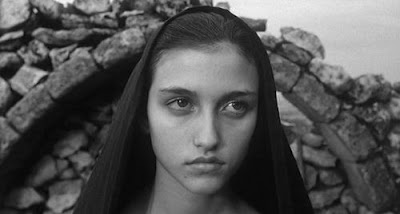“Let it flow”—A brief Advent meditation on true-entrusting (drawing on an intimation of Henry Bugbee's)
 |
| Margherita Caruso as Mary in Pasolini’s Gospel According to St. Matthew (1964) |
A short “thought for the day” offered to the Cambridge Unitarian Church as part of the Sunday Service of Mindful Meditation
(Click on this link to hear a recorded version of the following piece)
—o0o—
As I noted last week, we are in the season of Advent which, minimally conceived, marks the beginning of a period of reflective waiting and preparation for “that-which-is-to-come.” You may recall that I added, because the symbol of “that-which-is-to-come” in the Advent and Christmas myth has become so familiar to us — namely, the new-born Jesus as a representation of “divinity-among-us-never-gone” — it is easy to forget that the full nature of “that-which-is-to-come” can never be known beforehand.
But most of us have been educated within a highly professionalised, technocratic world-view that likes to insist, as the twentieth-century American philosopher, Henry Bugbee (1915-1999) noted, that one can and should be clear from the beginning about what premises and assumptions we start from and that the procedure and direction of thought and reflection worth undertaking should be equally clear. We have been taught a way of being in the world that is very suspicious of, and even highly disturbed by, the thought that the full nature of “that-which-is-to-come” can never be known beforehand.
But Bugbee was someone who came to live by a very different intimation, namely that “the reflection worth indulging doesn’t know where it’s going” (cf. August 27, 1952 entry in The Inward Morning: A Philosophical Exploration in Journal Form, University of Georgia Press, 1958/1999, p. 34-36).
This intuition encouraged Bugbee to learn to “let it flow”, i.e. to let his reflections about how the world is and is becoming flow freely with as few distorting predetermined premises and assumptions in play as possible.
His own practice of this way of proceeding helped him see that the basic, deep meanings of our world and our life in it are not things which can be anticipated but, instead, “they dawn on one” during the course of a flowing, unfolding life.
When he learnt to “let it flow” he found he was increasingly able to live a form-of-life that was not set up before him like an abstract puzzle to be solved but, instead, a vibrant, evolving and creative form-of-life in which meaning and worth was clarified for him and became something he knew deep “in [his] bones.”
I cannot but help think that in the Advent and Christmas myth when, after the birth of her son, Jesus, and all the extraordinary events that have occurred, Mary is a character who has begun consciously to live by the same intimation that Bugbee experienced. Luke tells us that she “kept all these things in her heart, pondering them” (Luke 2:19) and it seems reasonable to suggest that for her the reflection worth indulging didn’t know where it was going and yet, for all that, the myth also suggests something had been clarified for her that was not the solution of a puzzle but something she now knew deep in her bones.
Of course, none of this meant that “that-which-is-to-come” was now known to Mary — no one can ever know that — but was now known and clear to her was way of meaningfully going on, a way of true-entrusting (shinjin) that fully acknowledges the ever-present need for us all to learn to “let it flow.”


Comments